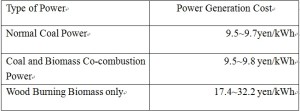In order to spread the use of renewable energy, Renewable Energy Feed-in Tariff (FIT) was initiated July, 2012. Biomass fuel, which is a source of renewable energy, is one of the beneficiaries of FIT.
However, when coal is burned with biomass fuel in a coal fired power plant, the power plant will be a target of FIT. This means that, out of the energy produced, the biomass portion will be the target of FIT and will be bought by electric companies at a fixed price as shown in figure 1.
Figure 1: FIT’s Provision Cost and Period of Biomass Energy

Coal Biomass Co-Combustion would Increase CO2 Emission
When biomass fuel is co-combusted at a coal fired power plant, the co-combustion ratio (the proportion of biomass fuel mixed with coal) is generally only 1~3% (ratio by weight. for wood biomass). About 97% of the fuel is still coal.
Coal fired power plants generally emit a great deal of CO2 (943g-CO2/kWh). Even if biomass suppress emission by 3%, coal fired power plants emit about twice as much CO2 as highly efficient combined-cycle LNG thermal power (474g-CO2/kWh), not altering the fact that coal is one of the main causes of climate change. Despite of this fact, the guarantee of 20 year provision period for biomass energy (figure 1) may increase the incentive to run coal fired power plant in the long term.
According to the report by the Japanese government, the cost of coal-biomass co-combustion is about the same as the cost of normal coal fired power (see figure 2). There is no need to make it a target of FIT.
Figure 2: Cost Comparison of Coal Power and Biomass Co-combustion

According to the data of approved FIT facility by the Agency for Natural Resources and Energy, one coal and biomass co-combustion power plant is already approved.
The use of FIT, a measure to promote renewable energy, to preserve coal fired power plants in the long term must be prevented. Coal and biomass co-combustion power should be eliminated from FIT.
1) Federation of Electric Power Companies “The Lifecycle CO2 Emission of Various Energy Source”
2) Cabinet Office National Strategy Office “Final Report by Cost and other Verification Committee” 2011
http://www.cas.go.jp/jp/seisaku/npu/policy09/archive02_hokoku.html
3) http://www.enecho.meti.go.jp/saiene/kaitori/dl/setsubi/201302setsubi.pdf
Author: Hirokazu Funatsu
Institute for Sustainable Energy Policies

